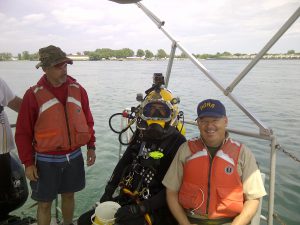A multi-agency team of researchers has begun a summer-long project to investigate chemical pollution in the Niagara River. The team will collect water, sediment, and mussel samples from various locations along a 25-mile stretch of the river and seven of its tributaries, all above Niagara Falls. Data from this sampling are expected to be available by year’s end to support local decision-makers and guide future monitoring efforts.

The Niagara River is one of 31 Areas of Concern so designated in the 1987 Binational Water Quality Agreement between Canada and the United States. The river presents unique logistical challenges, including strong currents, cold and high water, and excessive debris. The team has already completed one essential part of its mission under these arduous conditions. The U.S. Army Corps of Engineers Buffalo District Dive Team executed 20 hardhat dives with surface-supplied air to collect zebra mussels.
The project is supported with funding from theGreat Lakes Restoration Initiative. Project partners include: NCCOS, the U.S. Army Corps of Engineers (Buffalo District and Engineering Research and Development Center), EPA’s Office of Research and Development (Cincinnati, Ohio), the New York State Department of Environmental Conservation, and the University of Wisconsin -Milwaukee School of Freshwater Sciences.
For more information, contact Ed.Johnson@noaa.gov.
